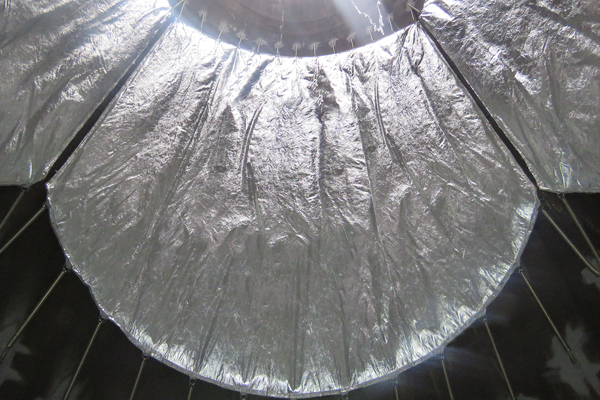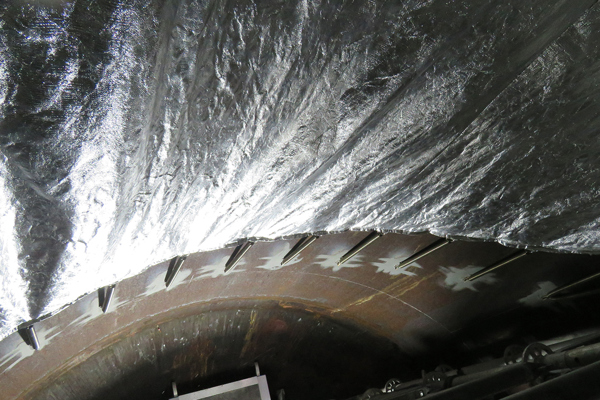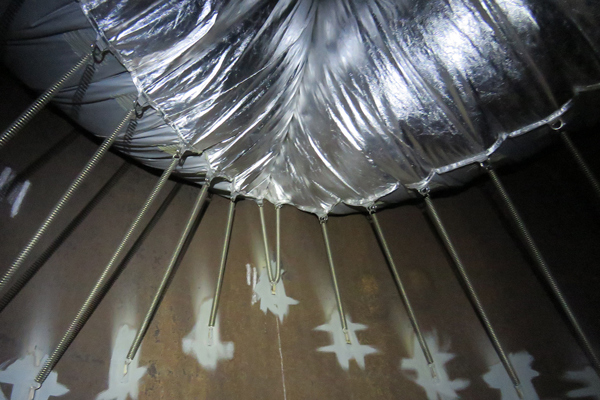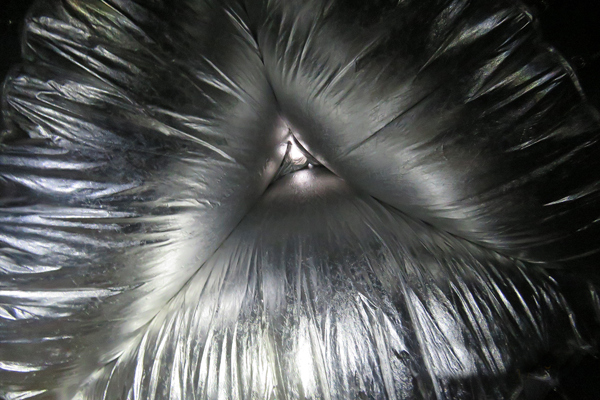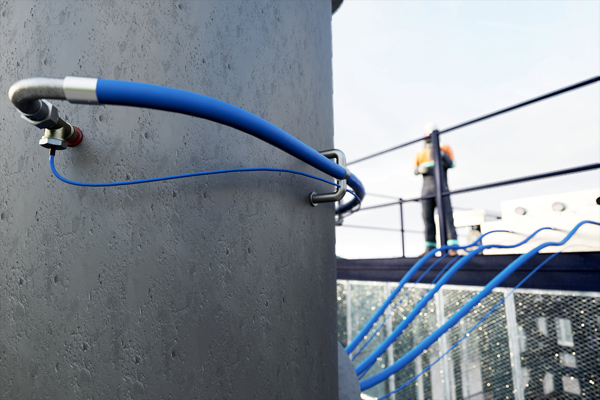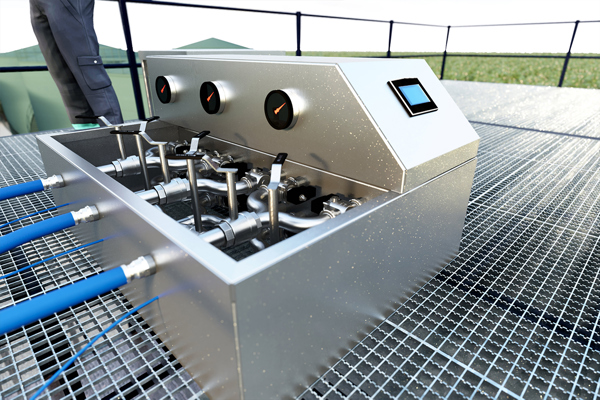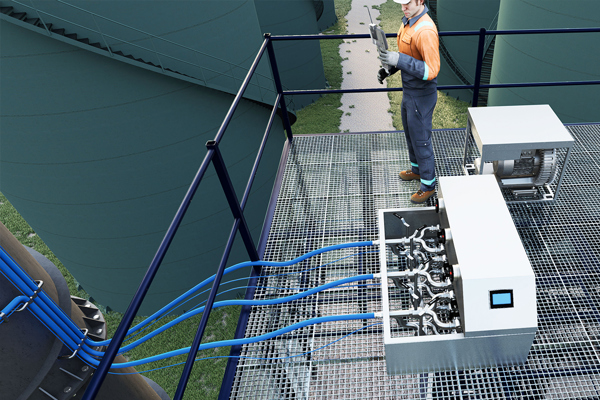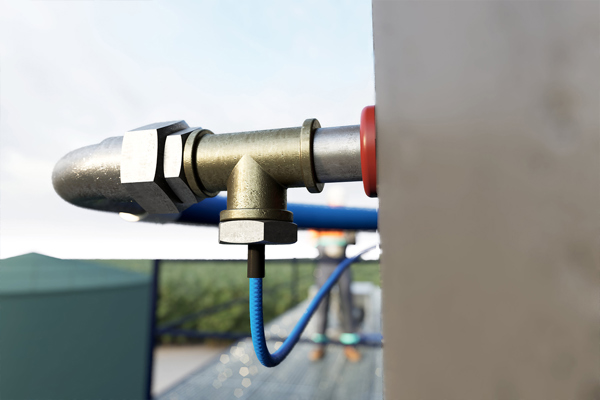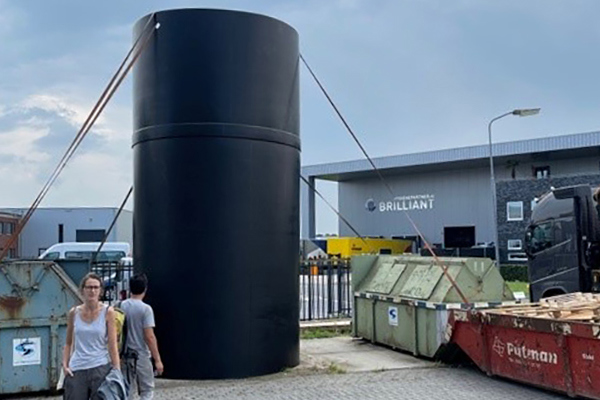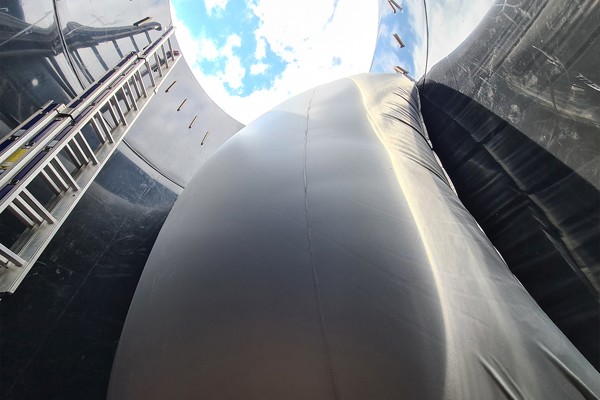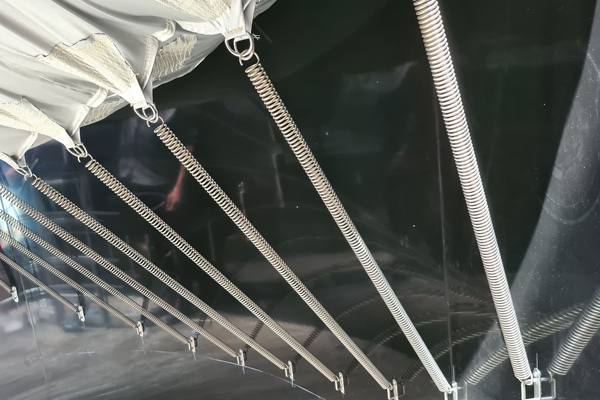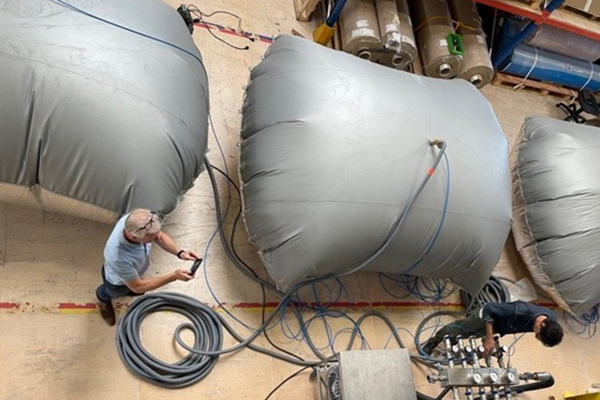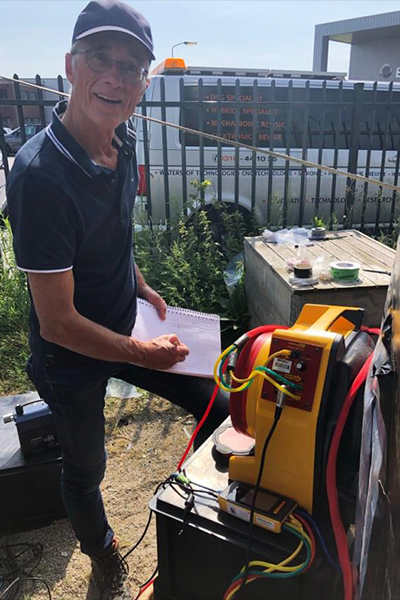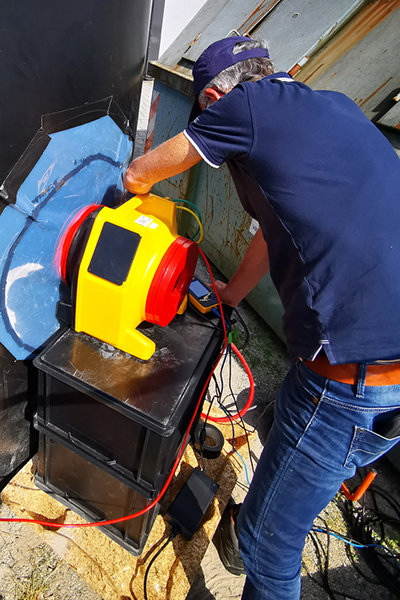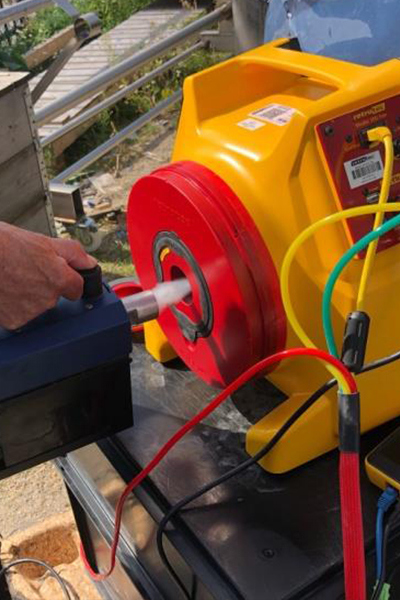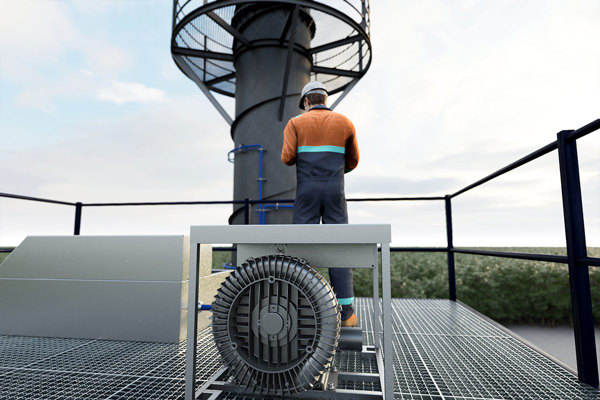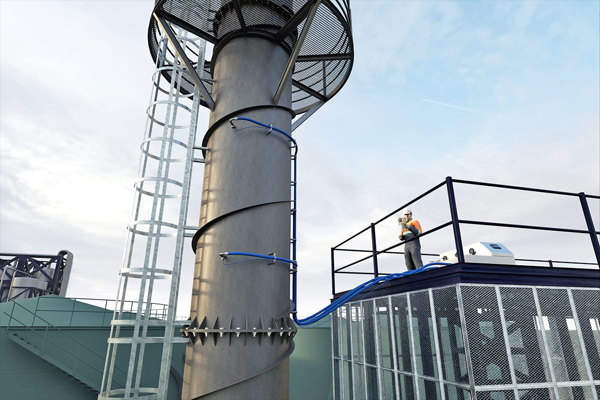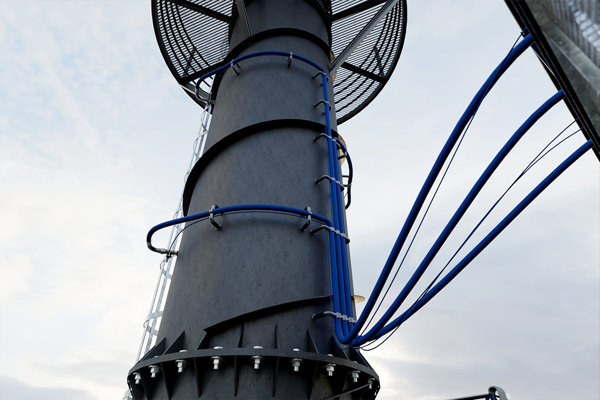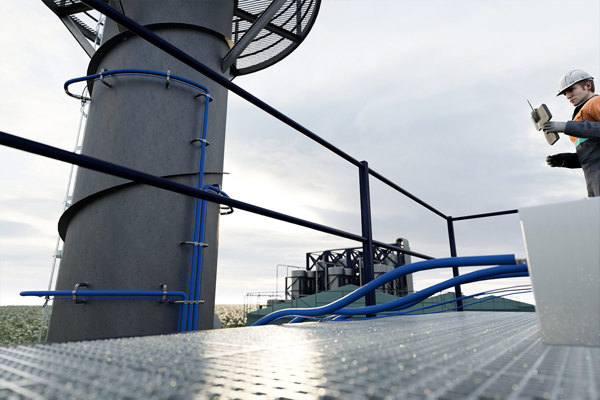- Architecture
- Industry
- Leisure
- Technology Center
- uk >
- Industry >
- Inflatable plugs >
- Inflatable CO2-emission reducer
Inflatable CO2-emission reducer
Inflatable, heat-resistant and insulating valves for reducing CO2 emissions from industrial chimney stacks.
Operation and purpose of the CO2-emission reducer
The purpose of Buitink Technology’s heat resistant inflatable valve is to reduce energy and heat loss and cut CO2 emissions from industrial chimney stacks.

Whenever a factory or a production process comes to a standstill – for example during maintenance work – a chimney stack that is temporarily out of action can often cause large unwanted emissions of heat and CO2.
It is at these times that Buitink Technology’s inflatable CO2-emission reducers can be automatically or manually filled with air, closing the chimney off and preventing hot air from escaping.
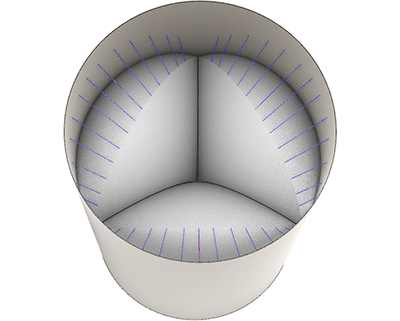
Chimney stack closed off:
to prevent loss of heat
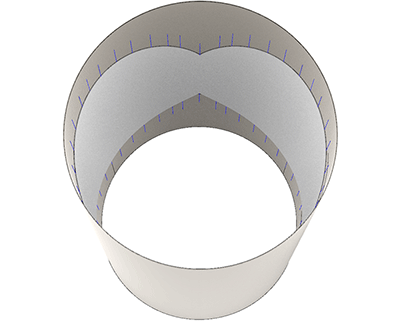
Chimney open for use:
discharge of combustion gases
Inflating chimney stack emissions reducers
The video below shows the inflatable CO2-emission reducer being inflated.
The reason Buitink Technology’s inflatable CO2-emission reducers are such a good choice is that they are compact and lightweight, which means they are relatively easy to retrofit in existing industrial chimney stacks.
Moreover, our inflatable chimney-stack valves become very flat when they are deflated and held flush against the chimney-stack wall. This means there is virtually no narrowing of the chimney opening so they do not hinder the passage and discharge of combustion gases.
Sustainable: retention of heat and reduced CO2 emissions
Many of Buitink Technology’s products and solutions actively contribute to cutting CO2 emissions. This applies in particular to our inflatable CO2-emission reducers for industrial chimney stacks.
A real-world example shows the huge energy savings and reduction of carbon emissions that can be achieved with a CO2 reduction system from Buitink Technology.
The above pictures show an industrial chimney stack (3 meters in diameter) in which Buitink Technology’s inflatable CO2-emission reducers have been installed.
Project data chimney-stack valve
| Diameter: |
3 meters |
| Exhaust air temperature: | 150 degrees Celsius |
| Air velocity in chimney during shutdown: | 45 km/hr |
In this real-world example, the loss of energy and the CO2 emissions without the Buitink inflatable CO2-emission reducers would be as follows:
| Energy loss: | 16.988 kWh/h (1.734 m3 natural gas/h) |
| CO2 emissions: | 3.462 ton/h |
You can find the complete energy loss and carbon emissions calculation here:
Robust, heat-resistant and resistant to air currents
An inflatable CO2 reduction system from Buitink Technology that is installed in industrial chimney stacks is robust, heat resistant and capable of absorbing the necessary forces created by air movements within the stack.
Our selection of the right materials from which the valves are constructed depends on environmental factors such as size, chimney stack diameter, maximum temperature and forces acting on the inflatable valves.
We also design the attachment points from which the valves are suspended in the chimney. After we have designed the attachment points, we run extensive in-house tests on them in our testing machine.
You can see an example of a general attachment point test here:
strength test for patches/handles
In addition to strength testing, we can also perform in-house fatigue tests. For an example, see:
Construction from special materials
Our selection of suitable materials from which to fabricate an inflatable CO2-emission reducer depends on the situation and the specific circumstances. We design the fastening and installation system to cope with the specific forces to which the inflatable valve will be subjected.
For example, the construction and selection of materials need to take account of:
- Operating temperatures (minimum and maximum temperature in the chimney stack);
- Composition of the gases;
- Air velocities in the chimney stack and accordingly the necessary material strength;
- Other requirements, such as minimizing the risk of explosion caused by friction (we make the outer shell of the CO2 reducer from a fabric with an anti static coating).
Our website contains some examples of sheets and coated fabrics that are designed specifically to withstand high temperatures and chemicals/gases:
We work out the extent to which strength and fatigue tests are needed on a project-by-project basis.
Turnkey delivery, including automatic and manual controls
We can supply a fully operational inflatable CO2 reduction system with all the necessary components: inflatable reducers, electric valves, air lines, measurement lines, fittings, manifold, air installation with automatic controls and remote monitoring and operation.
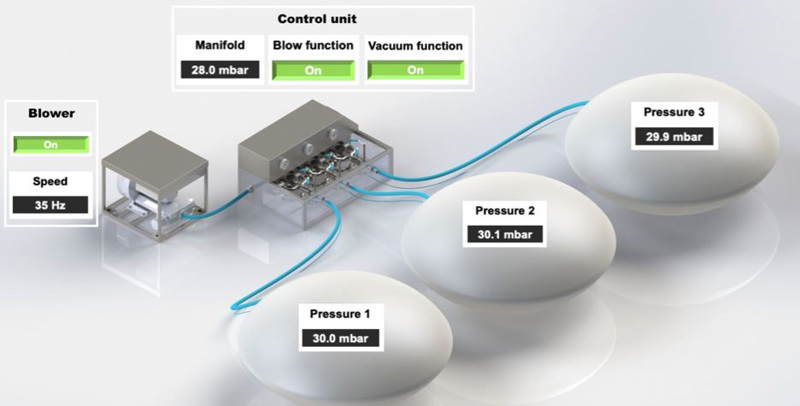
The control dashboard for the three inflatable CO2-emission reducers: the pressures can be set and monitored. The entire system is automatically inflated and kept at the right pressure.
Not only does the air system we supply fill the inflatable valves with air, it keeps them at the right pressure and deflates them after use.
Our air systems can also be operated manually using the manifold and manometers supplied. When the system is first commissioned, the right settings (especially the pressure) usually need to be found. This is initially done manually and then stored and programmed in the software that controls the system automatically.
Factory tested
We are able to test the system at our location in Duiven to minimize risks during commissioning. The testing takes account of the application, situation, preconditions and the requirements of our bespoke inflatable CO2 emission reduction system.
The assembly and installation of the system are often preceded by a great deal of preparation, and shutting down a factory process in order to install the valves is expensive. Therefore, if we are still uncertain about any aspects regarding how the system will operate, we simulate the assembly process and the operation of the valves as closely as possible on our premises. The situation in which the system will operate and how it is to be used determine whether this testing process is necessary or worth conducting.
In addition to real-world testing, we can also model the operation of our inflatable CO2-emission reducers and provide a statement of the forces that exist within the chimney stack and act upon the chimney wall.
You can find an example of one such inflatable chimney valve calculation (for indicative purposes only) here:
Chimney stack valve calculation
In addition to testing the behavior and shape when the valves are inflated and deflated, we can calculate how much air is lost when they close off the chimney. We have tested this on the above setup (three-meter diameter chimney stack). Conclusion: at a pressure difference of 100 pascals, the rate of air loss is only 42 m3/hour.
Test setup for measuring air loss when valves are closed..
The full measurement report can be found here:
Prefabrication, packaging and shipping
We deliver our prefabricated products all over the world. This also applies to our inflatable CO2-emission reducer. We can design, manufacture and supply all of the components required for commissioning, adjusting and operating the system so they are ready to use out of the box. We can also supervise assembly anywhere in the world.
Our inflatable CO2-emission reducers are compact and lightweight and can be shipped relatively easily and cheaply by air, sea or road.
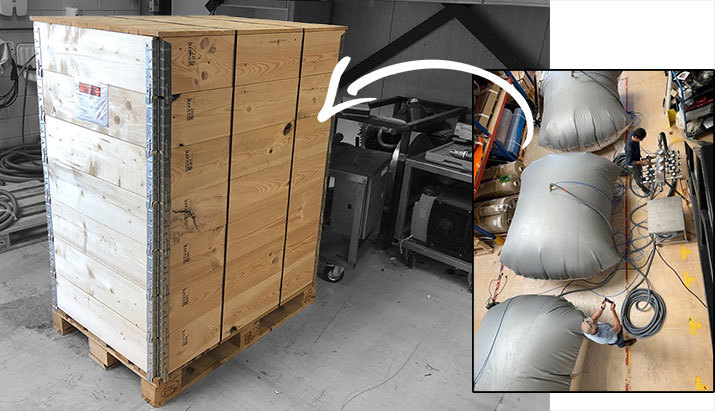
Three valves for a three-meter diameter chimney stack packed in a wooden shipping crate on a Euro pallet: 80 x 120 x 160 cm (L x B x H). Weight: 75 kg.
Advantages of our inflatable CO2-emission reduction system
A Buitink Technology inflatable CO2-emission reduction system features several important properties which give it an advantage over alternative solutions.
- With a relatively low investment, you can save a lot of energy is saved and cut your CO2 emissions.
- An inflatable CO2-emission reducer made by Buitink Technology is compact, very lightweight, foldable, flexible and can therefore be retrofitted in almost any industrial chimney stack;
- When not the air has been sucked out the CO2 reducer, it lies flat and tight against the chimney wall, so it scarcely hinders the free flow of combustion gases at all.
- We can deliver our prefabricated, plug-and-play inflatable CO2-emission reducers anywhere in the world;
- Buitink Technology’s inflatable CO2 emission reduction system can be fully monitored and controlled remotely;
- A major advantage of these inflatable valves is that they require very little maintenance. The inflatable valve is operated by a central air system that inflates it to close the chimney off or sucks the air out of it to open it. The only part that requires maintenance is therefore the central air system. An inflatable valve requires no lubrication, no filter changes, there are no parts that need to be periodically replaced, etc.
FAQ on the inflatable CO2 emission reduction system
What are the minimum and maximum chimney flue diameters for which the CO2 emission reduction system is suitable?
As it is a bespoke system, there are no real limits to the diameter of the chimney that you would like it to close off. Chimney flue diameters most commonly measure between 120 and 360cm, which is also the range of the systems we have built.
Doesn’t the empty CO2 emission reduction system obstruct the air flow in the chimney stack?
Our system can be permanently installed and remain in the chimney stack because when the valves are not inflated, they are held very tightly against the inner wall of the flue. The mass that might limit the airflow is essentially zero, as our research results confirm.
How quickly can a CO2 emission reduction system be ready for use?
From the moment the air supply is switched on, it takes an average of 4-5 minutes for the CO2-emission reducer to be completely filled and the chimney stack to be fully closed off. Obviously, the filling rate also depends on the inner diameter of the chimney stack.
What temperatures can the CO2 emission reduction system withstand?
Our engineers work out which materials the CO2 emission reduction system is to be built based on several factors, the most important being temperature and chemical resistance. We have a very wide range of materials to choose from and we sometimes combine several layers to achieve the optimal blend of properties.
Does it take a long time to install the CO2 emission reduction system?
Normally, we install the system as soon as there is a maintenance shutdown at the production site. With the right preparation, planning and, if required, installation supervision by our engineers, we can supply a complete plug-and-play system that can be operational in a short time.
Is the air supply always included?
For the CO2 emission reduction system to work properly, the inflation, pressurization and deflation of the inflatable elements must be carefully controlled. This is best achieved with a custom air supply that operates fully automatically and separately from other air systems.
How can we be sure that a CO2 emission reduction system will be an appropriate solution for us?
Obviously, every situation is different and the conditions can often change. It is for this reason that the testing of concepts and simulating real-world situations are always included in our offering. For instance, we can determine together whether a solution we have engineered would meet expectations before installing it in your process situation.
Are there any CO2 emission reduction systems that are not fitted permanently in the chimney stack?
We also supply valves that can be installed and removed with each service. Whether you choose this type of system or a permanent one will depend mainly on the accessibility of the location in which the valve needs to be fitted. Air is also introduced and removed with each service.
Does the CO2 emission reduction system have a long service life?
The service life of the CO2 emission reduction system will of course depend on how intensively it is uses and the conditions under which it has to operate. In addition, if parts do wear out, we can always carry out maintenance to extend the system’s service life. The system consists of very few to no moving parts so the risk of failure is minimal.
Would our own technical department be able to install a CO2 emission reduction system?
The system comprises the set of inflatable chimney valves and a complete air system that is in principle delivered plug and play to the end user, together with assembly instructions. An industrial technical service would normally be able to install it but our engineers are on hand to supervise if required.
More information
Buitink Technology is a resourceful company with original ideas and ingenious products. Call Buitink Technology: +31 316 25 08 30, email: [email protected] or leave your contact information:












 Call me
Call me More information
More information +31 (0)316-250830
+31 (0)316-250830